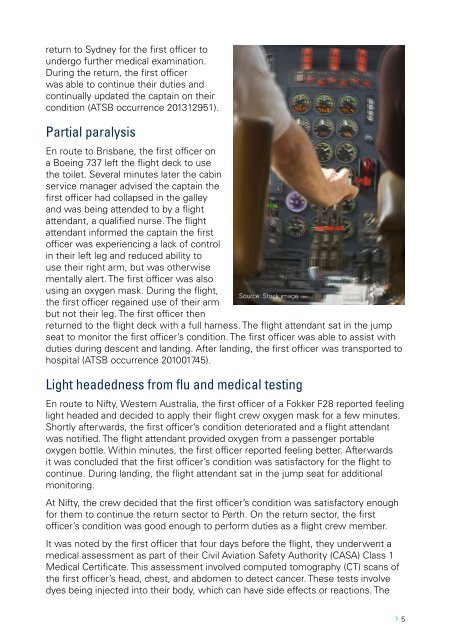Pilot incapacitation occurrences 2010–2014
8rKXy6YKY
8rKXy6YKY
You also want an ePaper? Increase the reach of your titles
YUMPU automatically turns print PDFs into web optimized ePapers that Google loves.
eturn to Sydney for the first officer to<br />
undergo further medical examination.<br />
During the return, the first officer<br />
was able to continue their duties and<br />
continually updated the captain on their<br />
condition (ATSB occurrence 201312951).<br />
Partial paralysis<br />
En route to Brisbane, the first officer on<br />
a Boeing 737 left the flight deck to use<br />
the toilet. Several minutes later the cabin<br />
service manager advised the captain the<br />
first officer had collapsed in the galley<br />
and was being attended to by a flight<br />
attendant, a qualified nurse. The flight<br />
attendant informed the captain the first<br />
officer was experiencing a lack of control<br />
in their left leg and reduced ability to<br />
use their right arm, but was otherwise<br />
mentally alert. The first officer was also<br />
using an oxygen mask. During the flight,<br />
Source: Stock image<br />
the first officer regained use of their arm<br />
but not their leg. The first officer then<br />
returned to the flight deck with a full harness. The flight attendant sat in the jump<br />
seat to monitor the first officer’s condition. The first officer was able to assist with<br />
duties during descent and landing. After landing, the first officer was transported to<br />
hospital (ATSB occurrence 201001745).<br />
Light headedness from flu and medical testing<br />
En route to Nifty, Western Australia, the first officer of a Fokker F28 reported feeling<br />
light headed and decided to apply their flight crew oxygen mask for a few minutes.<br />
Shortly afterwards, the first officer’s condition deteriorated and a flight attendant<br />
was notified. The flight attendant provided oxygen from a passenger portable<br />
oxygen bottle. Within minutes, the first officer reported feeling better. Afterwards<br />
it was concluded that the first officer’s condition was satisfactory for the flight to<br />
continue. During landing, the flight attendant sat in the jump seat for additional<br />
monitoring.<br />
At Nifty, the crew decided that the first officer’s condition was satisfactory enough<br />
for them to continue the return sector to Perth. On the return sector, the first<br />
officer’s condition was good enough to perform duties as a flight crew member.<br />
It was noted by the first officer that four days before the flight, they underwent a<br />
medical assessment as part of their Civil Aviation Safety Authority (CASA) Class 1<br />
Medical Certificate. This assessment involved computed tomography (CT) scans of<br />
the first officer’s head, chest, and abdomen to detect cancer. These tests involve<br />
dyes being injected into their body, which can have side effects or reactions. The<br />
› 5


